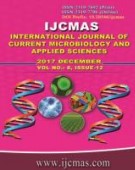


 National Academy of Agricultural Sciences (NAAS)
National Academy of Agricultural Sciences (NAAS)

|
PRINT ISSN : 2319-7692
Online ISSN : 2319-7706 Issues : 12 per year Publisher : Excellent Publishers Email : editorijcmas@gmail.com / submit@ijcmas.com Editor-in-chief: Dr.M.Prakash Index Copernicus ICV 2018: 95.39 NAAS RATING 2020: 5.38 |
Groundwater, the main source of irrigation, drinking or domestic purposes, is affected due to discharge of industrial effluents. The sugar industry contain remnants of chemical used for processing like caustic soda, sodium chloride, lime, sulphur and softening agents etc. and have potential to cause groundwater quality deterioration. In order to assess the quality parameters, ground water samples of various sources were collected from around the sugar mills placed at Gopalganj and Samastipur, Bihar. Altogether 30 groundwater samples were processed to detailed analysis of various parameters following the standard guideline of APHA, WHO study under investigation alarming pH ranges (6.8-8.6), 400-1350 mg/l of Ca2++Mg2+, CO32-+HCO3- (95-520ppm in terms of CaCO3) and (234.3-468.4) ppm chloride concentrations were obtained might be certainly problematic for drinking purpose. Amongst the parameters concentration of chloride, CO32-+HCO3- and Ca2++Mg2+ were found beyond the permissible limit (with increasing trend of Ca2++Mg2+ almost up to 8-10 km from both the sugar mills) for irrigation. Based on categorization of irrigation classes under the study indicated that the sources fall under either medium or high salinity hazards required special attention for irrigation purpose.
 |
 |
 |
 |
 |